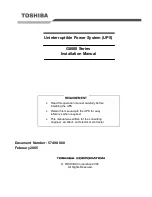
•
Use safety equipment.
Always wear eye protection.
Safety equipment such as dust
mask, non-skid safety shoes, hard
hat, or hearing protection used for
appropriate conditions will reduce
personal injuries.
•
Dress properly.
Do not wear
loose clothing or jewellery. Tie back
long hair. Keep your hair, clothing,
and gloves away from moving parts.
Loose clothes, jewellery, or long
hair can be caught in moving parts.
•
Avoid accidental starting.
Ensure the switch is in the
off-position before plugging in.
Carrying power tools with your
finger on the switch or plugging
in power tools that have the
switch on invites accidents.
•
Remove adjusting keys or
wrenches before turning the
tool on.
A wrench or a key that
is left attached to a rotating part
of the tool may result in injury.
•
Accessories and metal parts
can become very hot.
POWER TOOL
USE AND CARE
•
Use clamps or other practical
way to secure and support
the work to a stable platform.
Holding the work by hand or
against your body is unstable and
may lead to loss of control.
•
Do not force the tool.
Use the
correct tool for your application.
The correct tool will do the job
better and safer at the rate for
which it is designed.
•
Do not use the tool if switch
does not turn it on or off.
Any tool that cannot be controlled
with the switch is dangerous
and must be repaired. If there
appears to be a problem refer
to the “Trouble-shooting” and if
necessary contact a repair centre.
•
Disconnect the plug from
power before making any
adjustments, changing
accessories, or storing
the tool.
Such preventative
measures reduce the risk of
accidental starting.
•
Store tool in a dry location,
out of reach of children and
untrained persons.
This tool
is dangerous in the hands of
untrained users.
•
Maintain tools with care. Keep
cutting tools sharp and clean.
Properly maintained tools, with
sharp cutting edges are less likely
to bind and are easier to control.
•
Check for misalignment (ie.
excessive vibration), binding
of moving parts, or any
damage that may affect the
tools operation.
If damaged
have the tool serviced before
using. Many accidents are caused
by poorly maintained tools.
•
Never start the tool while
the blade is touching
the workpiece.
General Safety Rules
6
ADDITIONAL SPECIFIC
SAFETY RULES
1. Hold tool by insulated gripping
surfaces when performing an
operation where the cutting
tools may contact hidden
wiring.
Contact with a “live”
wire will make exposed metal
parts of the tool “live” and shock
the operator.
2. Be aware that this tool
is always in an operating
condition, because it does
not have to be plugged
into an electrical outlet.
•
Always wear safety goggles
or eye protection when using
this tool.
•
Position yourself to avoid
being caught between the
tool and walls or posts.
Should
the screw become bound or
jammed in the work, the reaction
torque of the tool could crush
your hand or leg.
•
Do not run the screwdriver
while carrying it at your side.
A spinning bit could become
entangled with clothing and
injury may result.
ADDITIONAL
SAFETY WARNINGS
FOR THE CHARGER
• Use only the charger supplied
in this pack.
• Protect the charger against
moisture including rain and
high humidity.
• Always check that the power
cord is correctly connected
before using the charger.
• When you are not using the
charger, remove the plug from
the mains socket. Do not pull
the plug out by the power cord.
• Always remove the plug from
the power socket before you
clean or maintain the charger.
• Do not charge the battery if
the ambient temperature is less
than -10°C (14°F) or greater
than 40°C (104°F).
General Safety Rules
7



























